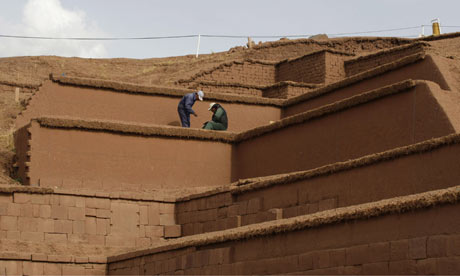
(above) Rather than clay bricks, the original Akapana pyramid is believed to have used stone. Photograph: David Mercado/Reuters
Makeover may lose Bolivian pyramid its world heritage site listing
October 20, 2009 - Guardian
As with all makeovers, it seemed a good idea at the time. The village of Tiwanaku in the Bolivian Andes reckoned it could attract more tourists by giving an ancient pyramid a facelift.
Workers plastered the Akapana pyramid – one of the biggest constructions in South America which predates the Incas – with adobe to make it look more impressive.
The problem, according to some experts, is that the new look is an archaeological travesty which could cost the pyramid its UN world heritage site designation.
Rather than clay bricks, the original construction, of immense spiritual significance for the Tiwanaku civilisation, is believed to have used stone.
"They decided to go free-hand with the design. There are no studies showing that the walls really looked like this," José Luis Paz, who has been appointed to assess damage at the site, told Reuters.
Officials from the UN heritage agency, Unesco, are due to visit Tiwanaku to determine if its main attraction should be removed from the list of world archaeological treasures.
It was included in 2000 because its ruins "bear striking witness to the power of the empire that played a leading role in the development of the Andean pre-Hispanic civilisation". The Tiwanaku civilisation, which reached Bolivia and parts of Peru, Argentina and Chile, existed from 1500BC to AD1200. The pyramid was thought to have been built between AD300-700 .
Paz, who heads excavations at the site, said the adobe not only looked wrong, its weight risked collapsing the pyramid. Thousands of tourists pay $10 (£6.50) each to visit every year and the people of Tiwanaku, he said, hoped to swell the revenue with a "more attractive" structure. Staff from the state National Archaeology Union (UNAR) did the renovation.
The motivation may have come from guides such as the Lonely Planet which noted the original Akapana pyramid, ransacked and eroded, "was in a rather sorry state".
Authorities defended the renovation. "The UNAR has restored the original form the pyramid had," the culture minister, Pablo Groux, told Reuters. "If we look at pictures from five years ago, there was just a hill there. What we can see now is something close to what the construction originally looked like."
He said Tiwanaku would not lose its world heritage status because the government halted the makeover earlier this year when told to do so by Unesco.
"The inclusion in the list of world heritage sites involves regular checks, because some places may lose the essence of why they were included in the list. In the case of Tiwanaku losing that title is unlikely," he said.